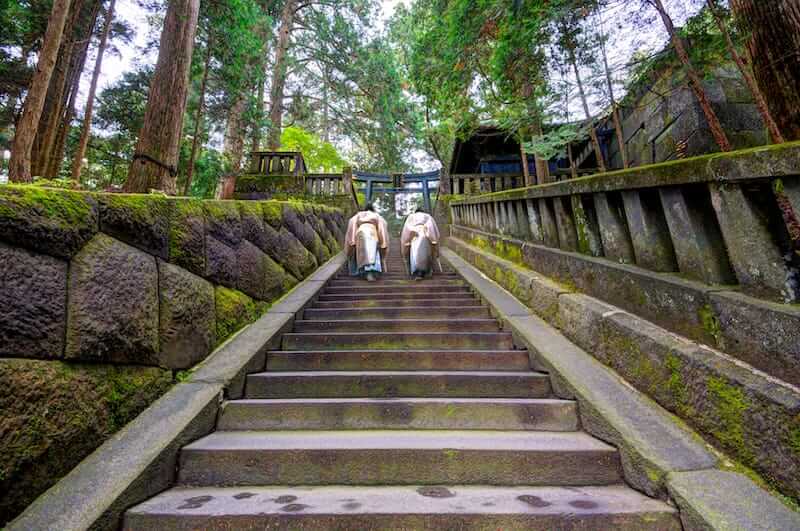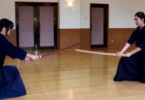Hi everyone how are you doing? Today’s theme is “Nikko Tōshōgu Shrine” which was registered as a World Heritage site in December 1999.
Contents
What’s Nikko Tōshōgu Shrine?
One of many big festivals held at Nikkō Tōshōgu Shinto Shrine which was established in 1617, just 402 years ago (as of 2019).
Nikko Tōshōgu is to enshrine Tokugawa Ieyasu, the first shogun (a general of the highest rank) of the Tokugawa shogunate, born in 1542.
After a great deal of hardship from an early age he succeeded in pacifying the country after a turbulent period of conflict and established the Tokugawa shogunate system in 1603.
His actions brought order and organization to Japanese society while promoting scholarship and industry.
Ieyasu laid the foundation for over 260 years of peace and culture during the Edo Period, greatly contributing to the development of modern Japan.
On May 17th and 18th 2018, Spring Grand Festival (Sacred Procession “Procession of the 1,000 Samurai”) was performed, including archery on horseback.
At this grand parade you will see armored soldiers and their pages as well as portable shrines in a gorgeous and sacred display that resembles a Japanese picture scroll.
“See Naples and then die”
When we see something of scenery great in Italy, you know an old saying that”See Naples and then die“、meanwhile the Japanese have a saying, “Never say ‘kekko’ (magnificent) until you’ve seen Nikko.” the Tōshōgu Shrine and its surroundings are mainly responsible for it.
Let me quote from the New York Times, much of Japan’s beauty, both natural and man-made, is a subtle attraction.
From bonsai trees to shoji screens, the esthetic inclination of Japan has usually been toward simplicity and miniaturization.
It is little wonder that this is the case on a volcanic archipelago the size of California, crowded with people and short of space.
So Japan is rarely considered a place of jolting scenic vistas or human monuments.
Yet the country does have spots that, at a glance, will make jaws drop.
Perhaps nowhere in Japan are more such experiences offered than in Nikko, 75 miles and a two- hour train ride north of Tokyo, owing to the handiwork of both man and nature.
Nikko is best known as the site of the Tōshgu Shrine, an explosion of color and craftmanship that is one of the most dazzling architectural specimens in Asia.ō
All gold and richly colored lacquer, decorated with elaborate carvings of all manner of beasts, plant life and gargoyles, Tsōhogu is Japan’s Versailles – lavish, ornate and monumental.
It is set in a vast green slice of towering cedar trees, a scene of serenity that not even the onslaught of endless processions of flag-waving, picture-snapping Japanese tour groups can entirely disrupt.
The Tōshōgu Shrine was built in the first half of the 17th century and was consecrated to the Tokugawa shogunate, the last of the five families of shoguns, or military dictators, who ruled Japan for nearly 700 years under the nominal leadership of an emperor.
Situated at the entrance to Nikko National Park, the shrine includes about 30 structures, nearly all of which have been designated by the Japanese government as national treasures or important cultural properties.
Construction of the vast mausoleum began in the early 1630’s and was completed in 1636, two decades after the death of Ieyasu, the first Tokugawa shogun.
His grandson Iemitsu oversaw the work, done according to Ieyasu’s instructions.
Its style is a baroque version of the architecture of the Momoyama period (1573-1598), which itself was known for a generosity of decorative detail.
In scale and appearance, Tōshōgu looks Chinese. To build it, 15,000 of Japan’s finest artists and craftmen were drafted into service, mostly from Kyoto and Nara.
It is said that 2,489,000 sheets of gold leaf were used in gilding various rooms and exteriors, enough to cover six acres.
What other features including mystical enegy shrines around Nikko?
Beginning in the town of Nikkō itself, the long main street leads to the Sacred Bridge over the Daiya River. The arched span, 92 feet long by 24 feet wide, is lacquered red with gilt metal ornaments and rests on two huge stone supports at either end, shaped like torii (shrine gates).
According to legend, the bridge marks the spot where a famous eighth- century Buddhist priest, Shodo, crossed the river on the backs of two giant serpents on his pilgrimage to Mt. Nantai.
The original bridge, built in 1636 for use by the shōgun and his messengers on their visits to the shrines, was destroyed by floods in 1902. It was rebuilt in 1907.
Just beyond the bridge is a monument erected by Masatsuna Matsudaira, one of the powerful daimyo, or feudal lords, of the 17th century.
Its inscription, dated April 17, 1648, states that he was responsible for the Japanese cedar trees, or cryptomeria, that were planted over the preceding two decades around the Nikko shrines and along the roads from the sacred bridge to several neighboring villages.
It is said that Masatsuna Matsudaira planted the trees because he was either a bit poorer or more stingy than the other daimyo, who contributed expensive offerings to the shrine.
The Japanese cedars, he figured, would take much time and work but would be less costly.
The 20 years of planting was completed in 1651. Today, 13,000 of the original trees still stand.
And along the pathways surrounding the shrines, the sweet scent of these cedar spires hangs heavy in the air.
A short walk from the Sacred Bridge are the famed Nikko shrines.
They are often referred to generically as Tōshōgu but in fact the shrine area has four main sections: Rinnoji Temple, the Tōshōgu Shrine, the Futaarasan Shrine and the Daiyu-in Mausoleum.
From the bridge, the Rinnōji Temple is on the right side of the avenue leading to the Tōshōgu Shrine. Once inside its front gate, the hombo, or abbot’s residence, can be seen on the right.
This is where Gen. Ulysses S. Grant stayed for eight days when he visited Nikko in 1879, two years after he completed his term as President.
The temple is best known for its main hall, called the Sambutsudo (Three Buddhas Hall) for the three huge gilded wood images it houses.
The three deities are 26 feet tall; the one on the left, Bato Kannon, is the most arresting in appearance, with the figure of a horse’s head sprouting from its forehead.
It is thought to be the incarnation of animal spirits and is worshipped as the deity for the protection of animals.
The Three Buddhas Hall itself, built in 1648, is the largest historical structure in Nikko, measuring 112 feet long, 84 feet wide and 85 feet high.
A few minutes’ stroll from Rinnōji is the entrance to the ōTshōgu Shrine of Ieyasu, founder of the dynasty of military dictators that ruled Japan from 1603 to 1867.
Ieyasu was a harsh overlord, who devised a system that heavily taxed the daimyo and kept them in court, where he could keep an eye on them.
Employing this system, he and his descendants brought more than two centuries of enforced peace to Japan after 150 years of wrenching civil wars.
The broad flight of 10 stone steps at the shrine’s entrance is called Senin Ishidan, Thousand-Men Stone Steps, so named because in early times common people were not allowed inside the shrine, but they could assemble on these steps during festivals.
Inside, there are more than a dozen main structures – a five-story pagoda, gates, storehouses, a well, drum tower, belfry, scripture library, palanquin shed, dance stage, covered corridors, two spirit shrine rooms and, up more than 200 steps on a hill behind, Ieyasu’s tomb.
Of this assemblage, the tomb is the one simple structure, a comparatively uncluttered black-and-gold building, with a stone monument protected by a lion and a crane statue. Most of the rest is a flood of extravagant, ornate craftsmanship. Viewing it is both dazzling and exhausting.
Probably most striking is the Yomeimon (Gate of Sunlight), which forms the opening to the oratory and main hall.
It is popularly known as Higurashimon, or Twilight Gate, because people want to inspect it until twilight falls.
Yomeimon is widely acknowledged as the most richly adorned traditional gate in Japan, a jewel reflecting many of the artistic techniques of the Momoyama period.
With its 12 columns and two stories, Yomeimon Gate is 23 feet long, 15 feet deep and 37 feet high.
Overhead, you see waves of carved, multicolored flora and fauna – lions, tigers, giraffes, foxes, badgers, tapirs, ducks, sages, princes, courtesans, children, peasants, unicorns, dragons, bamboo, flowers, pines twisting, growing, swarming, running, jumping, gamboling, growling and leering in every direction.
This is the representative example of the art that has made Tōshōgu famous, but it is also a style that has been branded sheer architectural decadence.
At the extremities of traditional Japanese architecture and design, it is said, are Tōshōgu and the Katsura Imperial Villa in Kyoto, with the latter representative of the elegant simplicity that has influenced modern design.
Praising Katsura and belittling Tōshōgu became the fashion in Japanese intellectual circles especially after a German architect, Bruno Taut, emigrated to Japan in the 1930’s and called Katsura ”an eternal thing,” comparing its significance to the Parthenon in Athens.
Mr.Taut’s enthusiasm caused Japanese intellectuals of the time to reappraise Katsura, a building that had been all but ignored for the previous 150 years.
The Japanese have been flocking to Nikko’s Tōshōgu, however, for centuries.
Wherever one’s esthetic sympathies lie, Tōshōgu’s appearance is not the result of the idiosyncratic or frivolous tastes of a powerful ruler.
Its style derives from its function. Tōshōgu was built to deify Ieyasu and thereby sanctify the authority of the Tokugawa shogunate.
(Indeed, Ieyasu was posthumously named East-Illuminating Incarnation of a Bodhisattva and made a Buddhist deity.)
Accordingly, Tōshōgu was designed to display its size and its costliness.
And the purpose of the elaborate ornamentation and detailing was to leave the observer with a sense of awe, dramatically demonstrating the wealth and power of the shogunate.
The cost of all this, and the resulting taxation of the feudal lords, leaving them too impoverished to mount challenges to the rule of the Tokugawa family, may have also been a consideration.
The symbolism and the storytelling in the carved images that adorn Tōshōgu’s many buildings are reminders that authority is to be obeyed.
For example, the sacred stable is decorated with a carved version of the three monkeys in the famous ”hear no evil, speak no evil and see no evil” poses.
Japanese scholars point out that this image is a reminder that in a feudal society the people are expected to follow, and that Japanese of the Edo period understood the point perfectly.
To underline that Tōshōgu’s style results from its function, it is sometimes noted that the shogun who built it also oversaw the design of a garden for Edo Castle that is said to rival that of Katsura in its serene simplicity.
The Futaarasan Shrine is a short way from the Tōshōgu Shrine. Futaarasan enshrines three Shinto deities that, according to belief, bring prosperity to the country.
Their origins can be traced to Mt. Futaara (the present Mt. Nantai).
In fact, the Futaarasan Shrine is three shrines: this one, one at the foot of the mountain on the shore of Lake Chuzenji and one at the summit.
At the entrance of the shrine near Tōshōgu is a striking bronze torii gate that is 22 feet high. Though Futaarasan boasts a Chinese gate, its style is more subdued than that of its famous neighbor.
At the southwest corner of the main shrine is an antique bronze lantern that is 7 1/2 feet high, called Bake-Doro (Goblin Lantern).
It is said to have assumed the shape of a goblin at night. One night some swordsmen slashed it; the scratches are still visible.
The Futaarasan Main Hall, built in 1619, is the oldest building in Nikko.
Just beyond Futaarasan is the Daiyu-in Mausoleum of Iemitsu, the third Tokugawa shogun. The layout of Iemitsu’s mausoleum is roughly the same as Tōshōgu but the scale is smaller, the style and ornamentation simpler and the crowds smaller.
Beyond Tōshōgu, Nikkō National Park, with its mountain scenery, ancient trees, rivers, lakes and waterfalls, is a concatenated topography created by volcanic activity with Mt. Nantai, a dormant volcano rising 8,150 feet above sea level, as its centerpiece.
The lava flows of eons past dammed up mountain streams on a high plateau, forming Lake Chuzenji.
The drive from the train station up to Chuzenji is a succession of hairpin turns, with the view back down the slope improving as you go.
At the top, the vista resembles a tree-covered Grand Canyon.
In autumn, it becomes a kaleidoscope of multicolored foliage, which is why the fall is Nikko’s most popular tourist season.

Chuzenji Ko(lake) with autumn foliage
Kegon (Flower Garland) Fall, nearly twice as high as Niagara Falls, is an outlet for Lake Chuzenji. The water runs through a forest and over the tree-lined escarpment, as if it had taken a wrong turn thousands of years ago and kept its aberrant course.
Then it drops nearly 330 feet in a 10-foot-wide ribbon, piercing the pool below. The result is a mesmerizing aquatic descent accompanied by a steady, pleasant rumble.

Kegon no Taki (waterwall) from Chuzenji Ko(lake)
Get relaxed in a hot spring
After a long day of enjoying the festival and events, why not rest your tired body in one of Nikko’s hot springs?
Nikko is home to a plethora of hot springs with varying water properties, such as Kinugawa Onsen, Kawaji Onsen, Yunishikawa Onsen, Kawamata Onsen, Okukinu Onsen, Okunikko Yumoto Onsen, Chuzenji Onsen, and Nikko Onsen just to name a few.
You can leisurely enjoy your time in the hot springs and taste local delicacies like “yuba” and Nikko soba.
One of Onsen (hot spring) in Nikko
Have a good time!























